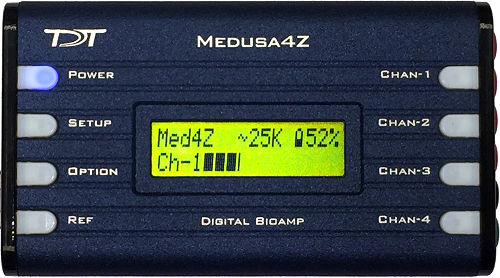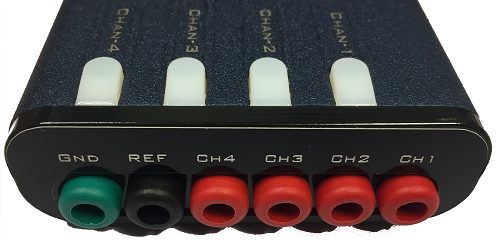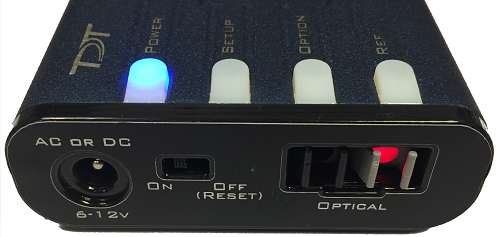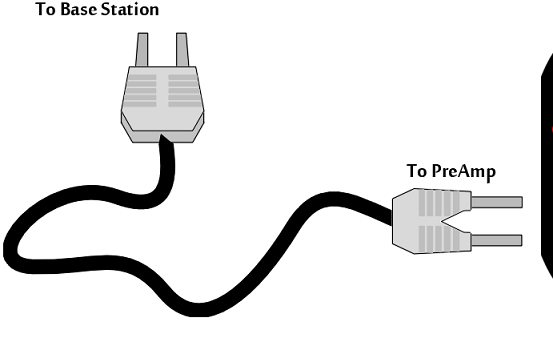Medusa4Z BioAmp

Medusa4Z Overview
The Medusa4Z is a four-channel, referential, low-noise digital bioamp targeted for use in low-channel-count, low-impedance neurophysiology recordings, such as ABR, EEG, EMG, or EKG signals. The bioamp digitizes one or four channels at acquisition rates of approximately 3 kHz, 6 kHz, 12 kHz, or 25 kHz, and the amplified digital signal is sent to the base station via a noiseless fiber optic connector.
Connections to the subject (four channels, reference, and ground) are made with six standard 1.5 mm touchproof safety connectors.
-
It is powered by a 5 AmpHr Li-Poly battery that provides up to 30 hours of continuous data acquisition in single-channel mode and up to 24 hours in four-channel mode.
-
It includes impedance testing functionality for each of the four recording channels as well as the reference electrode.
-
The user interface has 8 buttons and a 16 x 2 character LCD display screen. It lets you select performance characteristics of the preamplifier and shows battery and signal level.
-
A complete charge from a dead battery can be achieved in under 8 hours with the included charger.
Medusa4Z Features
The Medusa4Z has the option to be run in single-channel mode or four-channel mode. When in single channel mode, channels 2-4 are powered down and isolated from the reference line. Running in single-channel mode will provide slightly better performance and longer battery life.
There are selectable Sampling Frequency options of ~3 kHz, ~6 kHz, ~12 kHz, or system rate (maximum ~25 kHz). Users will find that using the lowest practical rate improves noise performance.
When testing the impedance of the probes, users can select frequencies of 100 Hz, 300 Hz, 500 Hz, or 1 kHz.
A user-selectable digital highpass filter has adjustable options that are: Off, 1 Hz, and 3 Hz. The hardware has a fixed analog highpass at 0.3 Hz.
An Auto Shutdown feature has three modes: Never, 1 hour, 3 hours, or 5 hours. If no buttons are pressed after this interval, then the device will automatically power down. If no optics are detected, the Medusa4Z will also shutdown. Before shutting down, the blue POWER LED will blink fast to indicate that time has expired. Pressing any key will reset the counter.
Analog Input Channels
The Medusa4Z Preamplifier acquires signals with 16-bit PCM ADCs. The signals are
oversampled before conversion to remove aliasing of high frequency RF signals.
This allows users to acquire at lower sampling rates (down to 3 kHz) with
improved signal-to-noise quality in that range and no aliasing. The Medusa4Z can
also acquire data in High-Resolution mode which uses 24-bit PCM ADCs. This is
controlled by the base station (RZ, RX) to which the Medusa4Z is connected. The
change occurs by modifying the underlying circuit running on the base station in
Synapse or BioSigRZ. This is the handled by default in Synapse
v92 and above, and
BioSigRZ v5.7.5
and above. In TDT Drivers v92 and above there is a RPvdsEx circuit macro available
in: C:\TDT\RPvdsEx\Macros\Device\Medusa4Z_Bioamp.
Electrode Connectors
Plug the electrodes directly into the standard 1.5 mm touchproof connectors on the side of the Medusa4Z.

Impedance Checking
The impedance checker on the Medusa4Z provides a simple check of the channel impedance relative to ground. To check the impedance level, press the button next to the channel indicator (e.g. CHAN-1). The impedance between channel and ground will be shown on the screen. The REF impedance button checks the impedance between the reference and the ground. Impedance checking frequency options are 100 Hz, 300 Hz, 500 Hz, and 1 kHz. These are settable on the user interface.
LCD Screen

The LCD screen shows the current sampling rate, battery level, and signal level indication on the active channels.
Use the SETUP button to cycle through available settings and use the OPTION button to change the currently selected setting. Settings include:
Active Channels: Single or Four Channel
Sample Frequency: ~3 kHz, ~6 kHz, ~12 kHz, System Rate (up to ~25 kHz). Match this to the desired frequency range of your acquired signal (maximum frequency captured will be ~45% of selected sample frequency). Note that lower sampling rates will have improved signal-to-noise, but they will also have longer sample delays. Please refer to the See Medusa4Z PreAmp Technical Specifications. for more information.
Probe Frequency: 100 Hz, 300 Hz, 500 Hz, 1 kHz. Choose the default frequency used for the impedance checker.
Highpass Filt: Off, 1 Hz, 3 Hz. Set the highpass filter cutoff frequency on the input signals. 'Off' is a 0.1 Hz filter. Note that there is a fixed 0.3 Hz highpass analog filter on the inputs.
Auto Shutdown: Never, 1 hr, 3 hr, 5 hr. After a period of inactivity the Medusa4Z will shut itself down to preserve power. This prevents dead batteries from accidentally leaving the unit on overnight.
Base Station Connector - Optical

Use the provided fiber optic pair (black cable, white connectors) to connect the OPTICAL port on the preamplifier to the optical input port on the base station.
The duplex fiber optic cable has identical one-piece connectors at each end. There is a V-shaped groove on one side of the connector and a raised rectangle on the other. As shown in the image below, plug the connector into the RZ6 port with the raised rectangle side up. Plug the connector into the preamplifier with the V-shaped groove up.
 |
| Medusa4Z Connection Diagram |
Power
The POWER button on the face of the Medusa4Z powers it on. Press and hold the button to power it off. Press the power button momentarily to go to the home screen from anywhere or to reset the power down timer.
Do not use the recessed slide power switch (ON OFF (RESET)) on the side of the device unless you need to reset all settings to factory default, or if you are storing the Medusa4Z for an extended period of time and want to completely disconnect the battery. The OPTICAL fiber connector at the right will be illuminated when the amplifier is on.
Power Requirements
The lithium battery charges in four hours. Keeping the battery charger connected to the amplifier does not affect the battery life. However, the charger will significantly increase the noise of the system if it is plugged in while an experiment is running. A 12 Volt battery charger is included with the amplifier. The supplied charger tip is center negative. However, tip polarity can be positive or negative if the charger needs to be replaced.
Note
If the Medusa4Z is powered on while charging, the charge circuit will halt when the battery is full. It will resume charging when the battery runs down to ~90%.
The lithium battery supplied with the system cannot be removed. If battery life longer than 30 hours is required, an external battery pack can be connected to the voltage inputs of the charger. TDT recommends a 6 V (minimum) to 12 Volt (maximum) battery, such as lead acid batteries used for motorized wheel chairs. Contact TDT for more information.
Medusa4Z Technical Specifications
Input Referred Noise
Depends on Medusa4Z sample rate and electrode impedance. All units in uVrms.
Sample Delay
Depends on Medusa4Z and RZ processor sample rates. All units in samples.